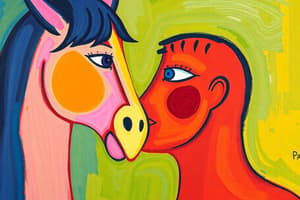Podcast
Questions and Answers
What is the key distinction between a stimulus and a response in the context of learning?
What is the key distinction between a stimulus and a response in the context of learning?
- A stimulus is a change in the environment that is felt by senses, while a response is a behavior manifested as a result of a stimulus. (correct)
- A stimulus always leads to a positive outcome, while a response can be either positive or negative.
- A stimulus is an internal thought, while a response is an external action.
- A stimulus is a voluntary action, while a response is an involuntary reaction.
What is the focus of behaviorism as a school of thought in psychology?
What is the focus of behaviorism as a school of thought in psychology?
- The exploration of unconscious desires.
- The analysis of cognitive processes.
- The emphasis on subjective experiences.
- The study of overt observable behavior. (correct)
In classical conditioning, what role does the neutral stimulus (NS) play before conditioning occurs?
In classical conditioning, what role does the neutral stimulus (NS) play before conditioning occurs?
- It does not naturally elicit a particular response. (correct)
- It elicits a reflexive response.
- It causes a conditioned response.
- It naturally elicits the same response as the unconditioned stimulus.
What is the defining characteristic of spontaneous recovery in classical conditioning?
What is the defining characteristic of spontaneous recovery in classical conditioning?
In the Little Albert experiment, what was the unconditioned stimulus (UCS)?
In the Little Albert experiment, what was the unconditioned stimulus (UCS)?
How does stimulus generalization manifest in the context of the Little Albert experiment?
How does stimulus generalization manifest in the context of the Little Albert experiment?
What is the core principle of operant conditioning?
What is the core principle of operant conditioning?
What is the effect of a pleasant consequence on a specific behavior in operant conditioning?
What is the effect of a pleasant consequence on a specific behavior in operant conditioning?
In the context of operant conditioning, if a rat presses a lever and receives food, what type of consequence is the food?
In the context of operant conditioning, if a rat presses a lever and receives food, what type of consequence is the food?
What does 'shaping' refer to in operant conditioning?
What does 'shaping' refer to in operant conditioning?
What is the key concept introduced by Tolman's research on latent learning?
What is the key concept introduced by Tolman's research on latent learning?
What is meant by the term 'cognitive map' in the context of latent learning?
What is meant by the term 'cognitive map' in the context of latent learning?
What is the defining feature of observational learning?
What is the defining feature of observational learning?
According to Bandura's social learning theory, what is the first step in the modeling process?
According to Bandura's social learning theory, what is the first step in the modeling process?
What is vicarious reinforcement in the context of social learning theory?
What is vicarious reinforcement in the context of social learning theory?
What did Bandura's Bobo doll experiment primarily demonstrate?
What did Bandura's Bobo doll experiment primarily demonstrate?
In Bandura's Bobo doll experiment, what happened when children observed an adult being punished?
In Bandura's Bobo doll experiment, what happened when children observed an adult being punished?
What is the key difference between classical and operant conditioning?
What is the key difference between classical and operant conditioning?
What is the purpose of using negative reinforcement in operant conditioning?
What is the purpose of using negative reinforcement in operant conditioning?
Which of the following scenarios is the best example of latent learning?
Which of the following scenarios is the best example of latent learning?
Flashcards
What is learning?
What is learning?
The process of acquiring new and relatively enduring information or behaviors through experience.
Associative Learning
Associative Learning
Making connections between stimuli or events that occur together in the environment.
Behaviorism
Behaviorism
A school of thought focusing on observable behavior, emphasizing objective measurement and scientific analysis.
Classical Conditioning
Classical Conditioning
Signup and view all the flashcards
Stimulus
Stimulus
Signup and view all the flashcards
Response
Response
Signup and view all the flashcards
Unconditioned Stimulus (UCS)
Unconditioned Stimulus (UCS)
Signup and view all the flashcards
Unconditioned Response (UCR)
Unconditioned Response (UCR)
Signup and view all the flashcards
Neutral Stimulus (NS)
Neutral Stimulus (NS)
Signup and view all the flashcards
Conditioned Stimulus (CS)
Conditioned Stimulus (CS)
Signup and view all the flashcards
Conditioned Response (CR)
Conditioned Response (CR)
Signup and view all the flashcards
Acquisition
Acquisition
Signup and view all the flashcards
Extinction
Extinction
Signup and view all the flashcards
Spontaneous Recovery
Spontaneous Recovery
Signup and view all the flashcards
Stimulus Generalization
Stimulus Generalization
Signup and view all the flashcards
Stimulus Discrimination
Stimulus Discrimination
Signup and view all the flashcards
Operant Conditioning
Operant Conditioning
Signup and view all the flashcards
Reinforcement
Reinforcement
Signup and view all the flashcards
Punishment
Punishment
Signup and view all the flashcards
Latent Learning
Latent Learning
Signup and view all the flashcards
Study Notes
Learning
- Learned behavior, distinct from instincts and reflexes, brings change and experience, incorporating knowledge and skills consciously and unconsciously.
- Learning involves acquiring relatively enduring information or behaviors through experience.
- Associative learning involves making connections between stimuli or events happening together.
- Behaviorism includes classical conditioning, operant conditioning and observational learning.
Behaviorism
- Behaviorism is a school of thought focusing on observable behavior.
- Key figures thought behavior should be observed and measured scientifically.
- Behaviorism shifted the focus from internal mental processes.
Classical Conditioning
- Classical conditioning associates stimuli to anticipate events.
- A stimulus changes the environment which is felt by senses.
- Response is a behavior that results from a stimulus.
Classical Conditioning - Example
- Before conditioning:
- Unconditioned stimulus (UCS) elicits a reflexive response (food).
- Unconditioned response (UCR) is a natural, unlearned reaction to a stimulus (salivation to food).
- Neutral stimulus (NS) doesn't naturally elicit a response (bell before conditioning).
- Food (UCS) causes salivation (UCR).
- During conditioning:
- A neutral stimulus and an unconditioned stimulus are repeatedly paired.
- The bell (NS) plus the food (UCS) cause salivation (UCR).
- After conditioning:
- Conditioned stimulus (CS) is a learned response after pairing with an unconditioned stimulus repeatedly.
- Conditioned response (CR) is the behavior caused by the conditioned stimulus.
- The bell (CS) can cause salivation (CR).
Classical Conditioning - Processes
- Acquisition is the initial learning when an organism links a neutral stimulus with an unconditioned stimulus.
- The neutral stimulus (NS) and unconditioned stimulus (UCS) must occur closely in time and repeat multiple times.
- Taste aversion can occur even if the interval is several hours and the pairing occurs only once.
- Extinction diminishes the conditioned response when the UCS isn't presented with the CS anymore.
- If food is no longer presented with the bell, the dog stops salivating to the bell.
- Spontaneous recovery involves a return of a previously extinguished conditioned response after a rest.
Classical Conditioning - Little Albert
- John B. Watson studied human emotion via classical conditioning.
- All behavior can be studied as a stimulus-response reaction.
- Conditioning principles can be used to condition human emotions.
- He conducted a study with Little Albert.
- Little Albert's acquired fear of specific stimuli generalized to other furry things, due to all stimuli being furry.
- Stimulus generalization is when an organism responds to similar stimuli.
- Stimulus discrimination means learning to respond differently to similar stimuli.
Operant Conditioning
- B.F. Skinner proposed the theory of operant conditioning.
- Organisms associate a behavior with consequences (reinforcement or punishment).
- Behaviors are more likely to reoccur with pleasant consequences/desired results.
- Behaviors are less likely to reoccur with unpleasant consequences/undesired results.
- Skinner experimented with rats and pigeons to determine how learning occurs through operant conditioning.
- A boy cleaning his room being rewarded a treat is an example of a pleasant consequence.
- A teen girl not cleaning her room and having phone taken away is an example of an unpleasant consequence.
Operant Conditioning - Skinner Box
- Skinner used the Skinner box to study operant conditioning.
- The Skinner Box is an operant conditioning chamber for animals containing a lever that dispensed food as a reward when pressed.
- Positive Behaviors:
- Rat pressing the lever and getting food, reinforcing it.
- Negative Behaviors:
- Rat pressing the lever and getting electrocuted, causing the rat to stop pressing the lever.
Operant Conditioning - Terminology
- Reinforcement increases behavior.
- Punishment decreases behavior.
- Positive adds something.
- Negative takes something away.
Operant Conditioning - Examples
- Reinforcement (+ve): rat pressing lever to receive food.
- Reinforcement (-ve): rat pressing lever to stop loud noise/bright light/getting electrocuted.
- Punishment (+ve): rat stops pressing lever to prevent electrocution.
- Punishment (-ve): rat stops pressing lever because it no longer receives food.
- Shaping establishes operant behavior through reinforcing closer approximations toward a desired response.
Cognition and Latent Learning
- Edward C. Tolman's research found that learning can occur without reinforcement, introducing a cognitive aspect.
- A cognitive map is a mental picture of a layout of an environment.
- After 10 maze sessions without food, rats quickly exited the maze in 1 trial with food showing that they had learned the way out.
- Latent learning is learning not immediately observable until a reason to demonstrate it arises.
- Children may learn behaviors from their parents that are not demonstrated until later in life.
- Children can learn the route to school from the parent driving there, but can not apply this until they drive or bike to school.
Observational Learning
- Observational learning is learning by watching and imitating others.
Social Learning Theory
- Albert Bandura suggested social learning theory, to explain learning without external reinforcement.
- Observational learning uses imitation and internal mental states.
- Modeling Process:
- Attention: focusing on behavior.
- Retention: remembering the behavior.
- Reproduction: performing the behavior.
- Motivation: the desire to copy the behavior.
- Motivation depends on what happened to the model.
- Vicarious reinforcement makes the observer more likely to imitate rewarded behaviors.
- Vicarious punishment makes the observer less likely to imitate punished behaviors.
Bandura's BOBO Doll Experiment
- Albert Bandura studied modeling aggressive and violent behaviors.
- Children watched adults act aggressively toward a Bobo doll, then were given time to play with it.
- Adults were either punished, praised, or ignored for their behavior.
- Children acted less aggressively if the adult was punished.
- Children acted more aggressively if the adult was praised or ignored.
Studying That Suits You
Use AI to generate personalized quizzes and flashcards to suit your learning preferences.




